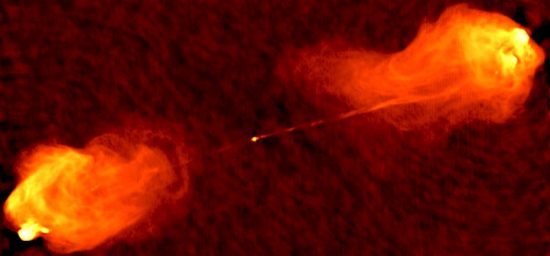
Radio image of jets and lobes in Cygnus A. Credit: NRAO/AUI
Jun 19, 2017
Electric power switches on and off.
From gamma-rays down through X-rays and radio waves, conventional theories rely on gravity and acceleration to produce radiation in space. Compressing dusty clouds of hydrogen gas is supposed to create enough transfer of momentum that they reach temperatures in the millions of degrees. That high temperature is supposed to make the gas and dust glow brightly and emit radiation.
The idea that electricity flows through the Universe is commonly met with resistance by today’s consensus, so its influence and attributes are unseen. It has long been said that “seeing is believing”. However, it should not be surprising that “believing is seeing” appears to be more apt. When there is no inner experience, such as a theory, outer realities remain invisible.
Electric charge surges out along galactic spin axes, forming double layers that, like those in 3C 405 (Cygnus A), can be seen as radio “lobes”. The electric charge spreads out around the galactic circumference, flowing back to the core along the spiral arms. Since the elements in a galactic circuit radiate energy, that energetic radiance shows that they are powered by larger circuits. The extent of the larger circuits may be traced by radio telescopes through the polarized radio “noise” coming from them.
Recently, astronomers using the Very Large Array found a “bright new object” near the center of Cygnus A. The conclusion is that there is second “supermassive black hole” (SMBH) orbiting the primary active energy source in the galaxy’s core.
Cygnus A is one of the first radio sources that revealed “jets and lobes” accelerating out of its nucleus. Those formations are thought to be the result of material falling into a compact gravity source, where it is torn apart. The resulting subatomic particles are propelled out of the galactic core by some means not understood in consensus circles. It is suggested that they are formed by the spinning magnetic fields that surround a black hole, but the theory can not be tested.
Among the many difficulties faced by mainstream astrophysicists is how magnetic fields can align and compress particle emissions into jets that maintain coherency. Radio jets from other galactic sources reach out for over one million light years before they “disperse” into vast clouds of radio emitting particles, larger than their galactic sources.
An important factor that is missed in these observations is that the fields are electromagnetic and not simply magnetic. The only way to generate a magnetic field is with the flow of electric charge, or electricity. As written in a previous Picture of the Day, radio-bright celestial objects are not created in gravity fields, no matter how powerful. Laboratory experiments most easily produce them by accelerating charged particles through an electric field. Rather than gravity, an electromagnetic entity called a “plasmoid” is responsible for jets, lobes and other objects in space.
The detection of another radio source in Cygnus A is indicative of plasma’s behavior in response to electric charge flow. Bennett pinches (z-pinches) in plasma filaments form plasmoids that can come and go as the electric field varies. Strong electric fields in plasmoids act as particle accelerators. Electrons accelerated to high speeds spiral in the electromagnetic fields, emitting radio waves. If the electric stress is high, another pinch will form. Radio telescopes confirm the existence of a plasma-focus plasmoid at the core of the Milky Way, so it should not be surprising that other galaxies exhibit similar structures that appear and disappear.
Stephen Smith
Hat tip to Tobias Perterka












